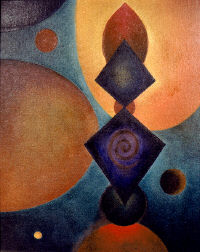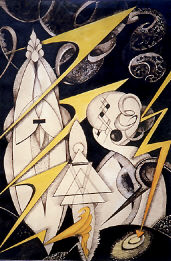
POWER AT THE CROSSROADS
DANE RUDHYAR. 1939
The Discovery of Painting: 1937-1944
During the late-thirties Rudhyar continued composing poetry, including the three long Apocalyptic Poems. His musical compositions from this period include the sections of Syntony for the piano now called Oracle and Eclogue, and sketches unfinished for an orchestral rendition, with recitation, of his long poem Paean To The Great Thunder. Many lectures were given in New Mexico, New York, San Francisco and Hollywood. In 1937 in Italy he joined Malya, who was returning ill after six months in India. While there he met and befriended psychologist Roberto Assagioli. In 1939 he started a Foundation for Human Integration which, for many reasons, was never fully developed.
During 1938 and 1939, while passing alone the summers in Santa Fe, New Mexico, Rudhyar began a new aspect of his public life. He began to paint and his work very soon attracted the interest of New Mexico painters and his works were exhibited in Santa Fe, Albuquerque, Phoenix and Ojai, California.
This new creative outlet was very significant, for there is a great difference between hearing (and this meant then exclusively playing at the piano) one's music extended in time, and being able to contemplate quietly and effortlessly one's paintings extended in space. Rudhyar found that the new esthetic experiences opened a new level of consciousness and he enjoyed it greatly. But circumstances did not allow him to paint as much as he would like. He nevertheless participated with Raymond Jonson and others in the formation of The Transcendental Painting Group, and the use of the term, transcendental, was his suggestion. A Transcendental Painting Foundation was started of which he became the vice-president. Rudhyar wrote the movement's manifesto, and an unpublished work entitled The Transcendental Movement in Painting. The latter treated not only painting, but other kinds of transcendental artistic endeavors, such as the dance of Martha Graham.
Rudhyar and the Transcendental Painting Group
The Transcendental Paint Group was founded by several non-objective artists struggling to establish abstract and non-objective art in America. The group included Raymond Jonson, Emil Bisttram, Lawren Harris, Alfred Morang, Agnes Pelton, Ed Garman, Horace Pierce, Dane Rudhyar and others. While many members shared an interest in theosophy and mysticism, and were inspired by the work of Wassily Kandinsky, mundane factors, such as needs for work space, exhibitions and publicity, actually brought the group together.
The Santa Fe Transcendental Painting Group is featured in the recent book Kandinsky and the American Avant-Garde: 1912-1950. The volume includes an essay on the Transcendental Painting Group by Marianne Lorenz and color plates depicting the work of its members.
Regarding Rudhyar's work and its place, Lorenz writes, "Rudhyar is unique among the artists being studied here because he emerged fully as a painter in the style of Kandinsky almost immediately. Philosophically and intellectually seasoned in the theories that underlay Kandinsky's art, his artistic development was not subject to the long search or evolutionary process that was the case of Harris and Jonson. Rudhyar discovered Kandinsky's vocabulary at the same time he discovered painting. As such, much of his oeuvre of the period, while often imbued with an almost heroic energy, quotes Kandinsky's formal language and reinterprets it in overtly theosophical or mystical terms. In works such as Storm Gods (1938, shown here), Rudhyar uses motifs from a number of Kandinsky's works illustrated in the 1936 and 1938 catalogues of the Guggenheim collection.

"Interestingly, Alfred Morang minimizes the influence of Kandinsky on Rudhyar, stating that 'the work of Rudhyar is built upon a non-objective pattern, but is not at all like the work of any other non-objective painter . . . His placing of shapes upon an oblong is not dictated by the rules of, let us say, Kandinsky or Picasso. Rather the motive force that actuates Rudhyar is a desire to the intangible something that he has learned to recognize through his music and his writing.'"
Rudhyar's paintings include works in vibrant colors, and many smaller black-and-white drawings. These paintings are non-representation, "abstract" or "symbolical." They aim at evoking inner states of consciousness and strong feeling-responses to rhythm and color combinations. Rudhyar uses pure colors, often in "dissonant" combinations which are blended and balanced in a manner creating what he calls in music "dissonant harmony." It is fundamental to realize, that none of Rudhyar's creative expressions emphasizes the technical, specialized approach which mark artists who work as "professionals." Indeed, Rudhyar fought against the attitude of professionalism in any art; for such an attitude binds the creation to ideological as well as esthetic standards, and very often to fashion. "Any art," he states, "should evoke an inner reality behind the outer forms, sounds or colors. The work of art of whatever kind, plastic or musical, should raise the feelings and the consciousness of whoever is faced with it to a higher level. To call this a 'mystical' concept is quite senseless. This has been the foundation of all great art in all cultures, except perhaps during their formalistic and 'classical' period during which virtuosity and 'art for art's sake' was considered the ideal for an often empty and bored aristocracy at some kingly or princely court."
Years passed devoted to the writing of articles for astrological and other types of magazines, with some time spent painting. This was in many ways a difficult period — the "dangerous Forties" of inner questioning and reorientation. World War II was impending; then, attention absorbing. Two books were written, the first, Man Maker of Universes proved unsatisfactory and only fragments were kept. The other, very long, The Age of Plenitude was almost accepted by a New York publisher but war pressures interfered. A small book, The Faith That Gives Meaning To Victory, was published in New York in 1942. It stressed Rudhyar's ideal of a global society and the true relationship of the individual person to "Man's common humanity."